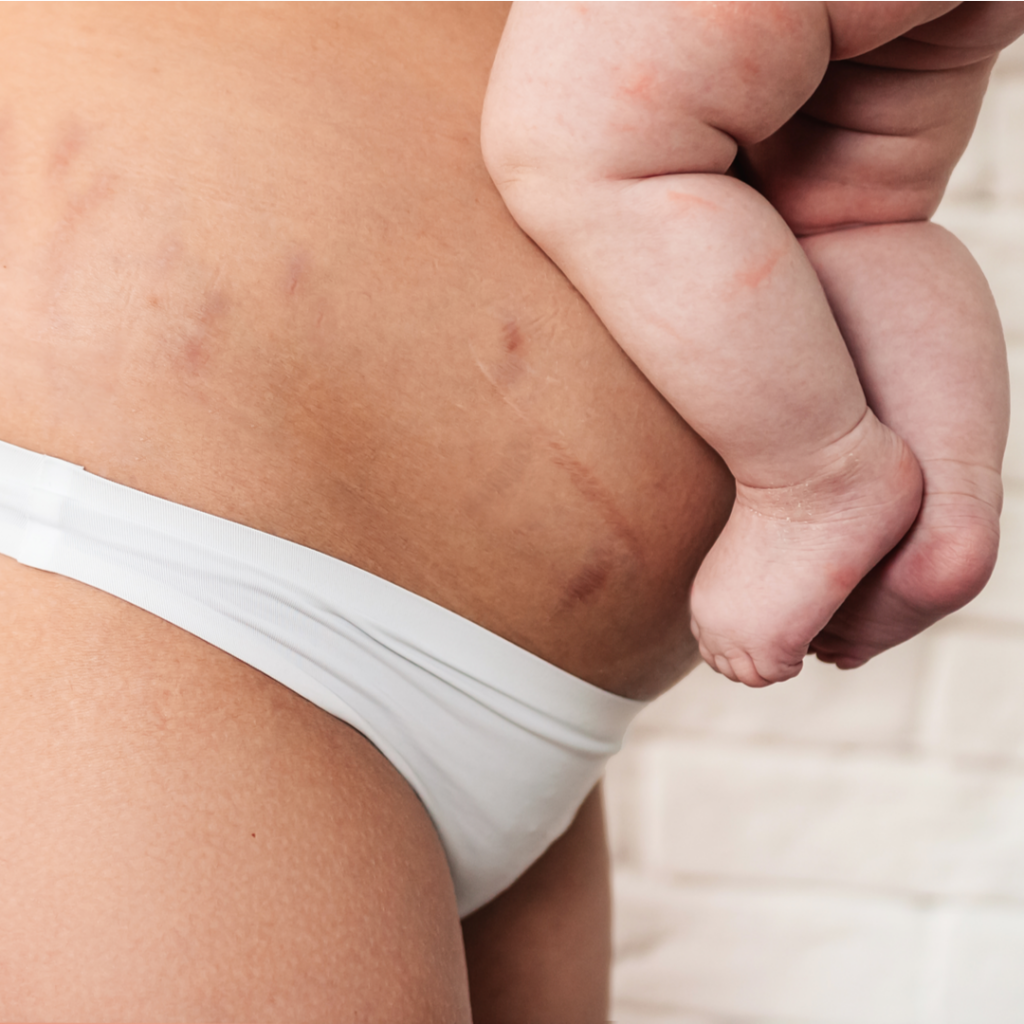There’s a lot of focus on pregnancy and having a baby, but not so much on how a woman’s body changes after childbirth. Many of these changes are due to the effect of pregnancy hormones and are only temporary, though some changes are more permanent.

It takes nine months to grow a baby – don’t expect your body to bounce back to what it was. Be patient and kind towards yourself and be realistic about recovery times.
Weight gain – it can take up to a year or more for women to lose weight they gained in pregnancy. The recommended amount of weight gain depends on a woman’s pre-pregnancy weight. The current guidelines are to use the Body Mass Index (BMI) scale to guide ideal weight gain.
Breast changes – during pregnancy, hormones prepare the breasts for lactation and breastfeeding. Most women experience changes in the shape and size of their breasts and nipples and when they lactate. Expect your breasts to go up a size or two when you’re pregnant and make time to be properly fitted properly for maternity bras.
Skin changes – it’s common for women to develop dark patches on their face during pregnancy. This is known as ‘the butterfly mask’ if it’s over the cheeks and nose. Chloasma is the correct name for these patches. Where a dark line forms on the tummy running from the navel to the pubic bone, this is called linea nigra. It can take a few months after the baby is born for skin to return to its normal shade.
Pelvic floor changes – many women describe a sensation of feeling less tone in their pelvic area after pregnancy and having a baby. This can cause incontinence (involuntary wetting) and not being able to ‘hold on’ to wee until getting to the toilet. In fact, one in three women who’ve ever had a baby wet themselves. Pelvic floor exercises make a big difference in regaining pelvic floor tone. Speak with your maternity care provider or GP about a referral to a physiotherapist who specialises in women’s health.
Pain – many women experience pain after childbirth, especially if they’ve had a caesarian section. Afterbirth pains are also common, especially when breastfeeding. They’re caused by the uterus contracting which helps it to get back to its pre-pregnancy size and shape.
Vaginal changes – after having a vaginal birth, most women experience vaginal changes including stretching/looseness and (at first) pain in the perineal area and when having sex. It can take a few weeks for vaginal tears and an episiotomy to heal and women are generally advised to wait six weeks before resuming intercourse. Being careful about hygiene helps healing and using a lubricant helps to avoid friction.
Body shape changes – most women become wider during their pregnancy. Their ribs expand, their hips widen and they gain weight over their hips, thighs and breasts. It can take several months for their body to regain its non-pregnant shape and size.
Tummy looseness – some women expect their tummy to return to its usual shape straight after their baby is born. But it’s normal to still have a rounded belly, with loose skin and overstretched abdominal muscles for at least a few months after birth.
Bleeding – it’s normal for women to bleed for up to six weeks after childbirth and to experience heavier bleeding during breastfeeds. Many women don’t resume their periods until after they’ve stopped breastfeeding, especially if their baby is still having breastfeeds overnight.
Stretch marks – are common on the tummy, breasts and thighs. They happen because of an inflammatory reaction in the skin because of tissue expansion. Stretch marks are more common for women who gain a lot of weight during their pregnancy.
Varicose veins – in the legs, ankles and vulva. Some women are more at risk of developing varicose veins. They tend to run in families and are more common in women who’ve had more than one baby. if you’ve been advised to have your varicose veins treated, this could be best timed for when you don’t plan to have any more children.
Hair loss – is common, especially from around four months after a baby is born. This is because during pregnancy, hair does not go through its usually retention and shedding cycles. More hair is retained which is why many women say their hair is thicker when they’re pregnant. Hair loss for women when their baby is around four months old is due to shedding of hair which was retained during their pregnancy. It does grow back, but can take a few months.
Larger shoe size – expect your feet to go up at least ½ size after you’ve had your baby. This is because of the effect of progesterone, the hormone which has an effect on loosening ligaments. It’s not just the ligaments and joints in the pelvis which are affected, but the mother’s feet as well.
Emotions – it’s normal to have mood swings and feel moody and even unstable after having a baby. Most women go through a period of emotional adjustment as they transition to becoming a mother. A little worry, frustration and anxiety are normal and mostly temporary. However, some women experience significant depression and anxiety after having a baby. Help and support is available and often starts with a conversation. If you are feeling sad or are not enjoying your baby, speak with your GP and Child Health Nurse. You are not alone.
New ways of looking at things – it’s common for new mothers to reflect back on what they once considered to be important and reprioritise. Nature has designed parents, especially mothers, to place their baby’s needs above all else, even themselves. Be open to changing your mindset about work, friends and how you spend your time.
Speak with your maternity care provider, GP and Child Health Nurse if you need any support and guidance.
Written for Infacol by Jane Barry, Midwife and Child Health Nurse April 2022



